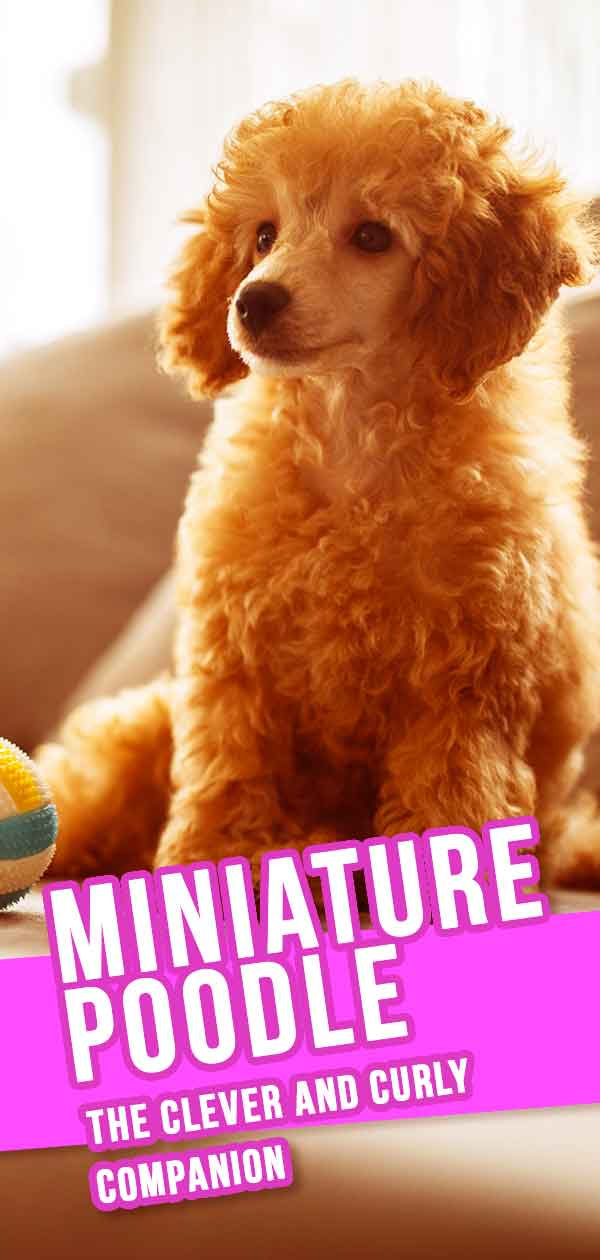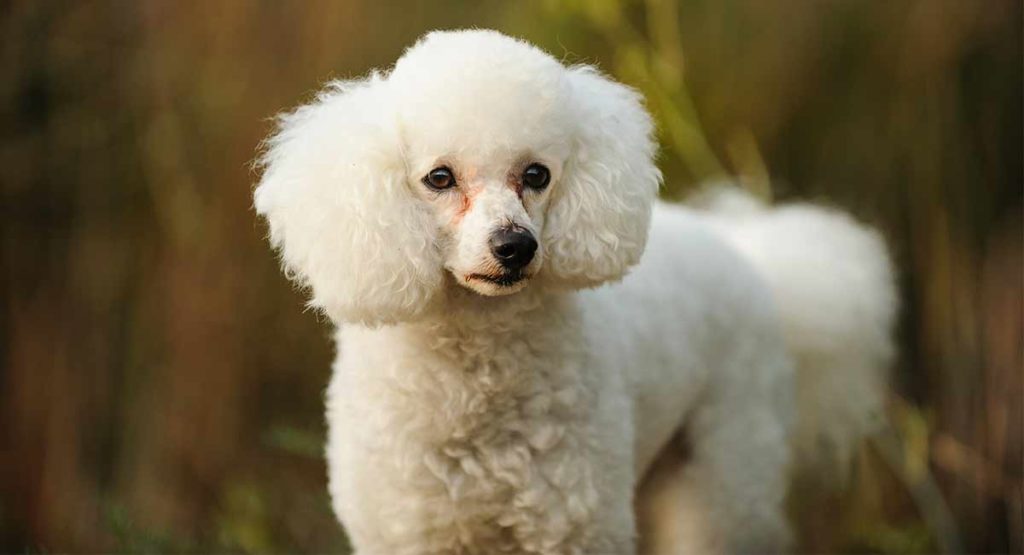
The Miniature Poodle dog breed is hard to beat when it comes to pets. A small, agile and intelligent pup with a low shedding, curly coat, this mini Poodle type has a playful, inquisitive personality and gets on well with people of all ages. Miniature Poodles have a range of colors including apricot, red, grey, brown and white, and patterns like parti. They reach up to 15 inches in height when full grown. Despite its name and small size, they are the medium of three Poodle varieties. Much smaller than the Standard and a little bigger than the Toy. This family friendly, affectionate companion can also make a great working, retrieving, therapy or service dog too. A healthy, energetic, proud and elegant breed, they can live up to 18 years.
Contents
- Miniature Poodle origins
- Colors, shedding and grooming
- Temperament and behavior traits
- Training and exercise
- Miniature Poodle puppies
In the right home with an active family, the Miniature Poodle makes an excellent companion. If you want a pup that’s cute, loyal, child friendly, a breeze to train, and doesn’t take up much space. This could be your dream dog.
However, if you hate grooming and can’t afford a professional to clip your pet, or if you don’t like long walks or ball games, then you might need to think again. Despite being small enough for your lap, the fun loving mini poodle is more athlete than couch potato and needs an hour or so of exercise each day. Miniature Poodles excel at agility and obedience and will love to accompany you on a jog around the park.
Working Origins
The Miniature Poodle is a beautiful, curly-coated dog breed. Originally bred as a hunting companion, they now make loyal pets and intelligent agility dogs. Some may think of Poodles as divas who would rather sit pretty on a cushion than get dirty, but au contraire!
Poodles began as duck-hunting dogs nearly 400 years ago. Contrary to what some may think, these hunting dogs were bred in Germany, not France. That’s right, there’s no such thing as a French Poodle.
Even though their luxurious coats look ready for a show, they kept the water-loving dogs warm as they retrieved game for their masters. The Poodle’s ancestors rose in popularity across Europe, but not just as duck hunters. Poodles became known for their success as truffle hunters, military dogs and even circus dogs!
Fun Facts!
- The French name for the Poodle is Caniche, which is a derivative of the French word for female duck.
The English word Poodle is derived from the German, Pudel, which is derived from another German word meaning “splash in water.” - After decades away from the hunting field, the breed is making a resurgence there as more and more Poodles are being used in hunting. Poodles are considered the second most intelligent dog breed. It’s no wonder the breed is so popular. In fact, they’re so popular, they’re probably the most recognizable dog breed.

Miniature Poodle Appearance
You don’t have to be a dog expert to know a Mini Poodle when you see one. Their curly coat is often clipped in distinctive patterns. Underneath all that fur is a surprisingly well built little dog. The Mini Poodle has a square conformation so that its weight is evenly distributed across all four legs with no undue pressure on the dog’s back. This give Poodles power and balance and enables them to jump much higher than their own body height, and to turn and twist at speed.
The Miniature Poodle has a nice level back, tight feet and an even gait which adds to the balanced, elegance of the dog. Their long straight muzzle enables the Poodle to cool efficiently and their bright intelligent button eyes are set in a pretty face framed by ears that hang neatly down on either side.
The result of this, even though it may be hidden under those gorgeous curls is a little athlete of a dog that is capable of both endurance, and of great bursts of energy.
How big is a fully grown Miniature Poodle?
Full grown, the Miniature Poodle may reach from 10 to 15 inches tall at the shoulder. Miniature Poodle weight ranges between 10 and 15 pounds.
A balanced diet appropriate to your dog’s age is important. You’ll want to monitor your dog’s caloric intake and weight. Don’t forget to include treats in that calculation.
Any dog will become overweight if fed too much or not given enough exercise. Because excess weight will exacerbate some of the health issues facing Miniature Poodles, it’s important to avoid it.
Miniature Poodle Coat Colors
Miniature Poodles are typically a single solid color, with several beautiful shades that highlight their beautiful curls. Here are the coat colors for show-quality Miniature Poodles (those who meet registration requirements):
- Apricot
- Black
- Blue
- Brown
- Cream
- Gray
- Red
- Silver
- Silver Beige
- White
If a breeder tries to sell you a bicolored Miniature Poodle as show-quality, know that the AKC does not accept bicolored Miniature Poodles or any color other than those listed above.Sometimes, the color names used are more fun, such as mini chocolate Poodle for a brown pup.
Miniature Poodle Grooming
How you keep a Miniature Poodle’s coat determines how much maintenance is needed.
If you keep your pup fully furred and unclipped, her curls or waves will require daily brushing. The fur closest to her skin will quickly become matted if not carefully groomed.
Because of their high-maintenance coat, most owners opt to clip their pup. There are several popular cuts that require varying degrees of maintenance.
If you keep her coat clipped short overall, you may be able to get away with less brushing and combing.
You’ll need to plan for visits to the groomer every four to six weeks to maintain the cut and trim her nails.
If you keep her coat partially clipped and partially long, then you’ll still need to maintain her long hair with daily brushing/combing. The clipped areas will need re-clipping every four to six weeks.
Shedding and Allergies
Their long and thick curly or wavy coat is iconic. Sometimes, you’ll see a Poodle with his hair clipped short. He may be only partially clipped, with only a few parts (typically the head, ears, chest, and legs) fully furred.
While this clip may seem like a fashion statement, it served a purpose back in the day. It protected the hunting dog’s vulnerable parts from cold and aided in swimming.
Today, clipping makes grooming easier for owners as their medium length coat requires regular attention. Regardless of how you keep his coat, a Miniature Poodle will bless you with a dramatic lack of shedding. He will still shed, but minimally: Every dog sheds at least a little.
Although they are a low shedding breed, they do still produce dander. This means that somone with a severe dog allergy could react to their salivia or contact with their fur.
Miniature Poodle Temperament
Poodles are generally friendly, and the Mini Poodle is no exception. However, they can be a little shy and leery of strangers. That, combined with their love and loyalty to their owners, means that some may growl at strangers. In extreme cases, they may bite.
Therefore, it’s important that you socialize a Miniature Poodle with new people and animals from puppyhood onward. Other than a possible distrust of strangers, Poodles are very intelligent dogs who are eager to please. They are easy to train and enjoy having their smarts and retrieving capabilities put to the test!
Training and Exercise
Because they are so intelligent and eager to please, training is relatively easy. However, that intelligence requires that you are consistent and positive in your training efforts.
These dogs can be rather rambunctious little critters who enjoy about an hour of daily play time and plenty of interaction with their owners.
A bored Miniature Poodle will be an unhappy one, so this breed is best suited for a household that will keep them entertained, even if in short spurts.
Since their descendants were bred as working dogs, it’s natural that they prefer something to occupy their bodies and minds! Toss a toy around for a Mini Poodle, and he’ll be happy to continuously fetch it for you. Just be sure to let him take a quick power nap in your lap in between games of fetch.

Miniature Poodle Health and Care
Like any purebred dog, Miniature Poodles are susceptible to several inherited health conditions. In addition to the health conditions found in those articles, they may also be prone to the following:
Cushing’s Disease
Generally found in small and older dogs, it’s caused by tumors on the adrenal gland. Once Cushing’s has been diagnosed, the dog may require lifelong medication, surgery to remove the tumor(s) and/or radiation therapy.
Diabetes
According to a 2002 study, Miniature Poodles seem prone to inherited diabetes. As with humans, diabetes in a dog requires lifelong insulin therapy.
Mitral Valve Disease
A malfunction of a heart valve causing blood to leak from one chamber in the heart to another, often referred to as leaky valve disease.
Tracheal Collapse
This progressive condition is exactly what it sounds like. This makes the dog unable to breathe normally and may cause coughing. Medication is required to help the dog breathe normally, and surgery is a last resort to correct the deformity.
Blepharitis
This is an inherited, allergic or secondary inflammation of the eyelid that closely resembles conjunctivitis (pink eye), in which the eyelid is red, swollen and itchy, sometimes with a clear or yellow discharge. Constant drainage can lead to loss of pigment or fur around the eye.
Degenerative Disc Disease
This is the spontaneous slippage or rupture of the discs that reside between the spinal vertebrae due to trauma or degeneration due to age. This is painful and can lead to hind-end paralysis. In some instances, genetic testing can identify dogs that carry the genes responsible for health problems. Dogs who are known carriers of these genes should not be used for breeding.
Miniature Poodle Lifespan
As a smaller dog, Miniature Poodles typically enjoy a longer life expectancy. Their lifespan ranges from 10 to 18 years. Most Mini Poodles live about 14 years and some make it all the way to 18!
Miniature Poodle Puppies
Anyone can breed a dog and sell the puppies. In most countries, there are no laws restricting or regulating dog breeding. That means that there are good dog breeders and there are bad dog breeders.
The worst breeders don’t care about the animals other than how much money they can make. So, you need to pick your puppy supplier very carefully indeed. Be sure to do your research on breeders before selecting a Miniature Poodle puppy.
As mentioned, show-quality Poodles are one color, so be wary of any breeders who advertise “show-quality” bicolored puppies. Select a breeder who uses genetic testing to prevent passing on undesired traits to help ensure the health of your puppy. Don’t be afraid to ask a lot of questions. Good breeders will appreciate your diligence.
A good breeder will keep their breeding stock and puppies healthy, at a good weight and in clean and spacious living conditions. Avoid any breeder whose dogs appear in poor health and/or dirty quarters.
These breeders may not want to let you see all their dogs. You should ask to see the mother with her pups. If the father is available, it’s good to meet him too.
Miniature Poodle Prices
Prices for Miniature Poodle puppies depend on how many are available, how much the breeder has invested in the puppies’ health and how valuable the parent dogs are to the breeder.
Additionally, some colors are more popular than others (hello, gorgeous apricot Poodles!). Therefore, you may pay more for a pup with a highly desired coat color.
Show-quality Miniature Poodle puppies will cost more than non-show-quality puppies.
In general, you can expect to pay anywhere from several hundred dollars to roughly $2,000 for a purebred Miniature Poodle puppy. Of course, you should understand what’s involved in raising a puppy before you bring one home.


Ava Avila says
I am picking mine up on Sunday! So excited, love this guide! ❤❤
Alexandra McLellan says
Question: What is the average length of a Poodle’s tale from the butt? I have a puppy that has not had her tail bobbed and I am going to have it cut to a proper length.
Joe says
I like miniature poodles a lot
Joe says
I am getting a miniature poodle it will be awesome!
Barry Drubin says
We just lost our Clicquot a 16.5 year old mini-Poodle and we are heart-broken. We do have another dog at home, a 6 year old Chihuahua/Rat-Terrier. My wife has really been affected by this very recent loss, (10/02/2019) and I’m thinking of adopting a young female apricot mini-Poodle. My wife as yet knows nothing about this idea so this is all new and in about 6 months we are moving into a new house so my timing might not as yet be appropriate. This does give me time to research breeders, etc. We live in Florida. Any suggestions would be appreciated.
Jerry says
I and my wife had our first miniature poodle for 14 years. Our Ceaser passed away in December of last year. My wife and I were very upset and we wanted another miniature poodle as soon as possible. We found Paris in May of this year. She was bred by a very reputable breeder. Like all miniature poodles she is friendly, very smart, and very loving but she does require attention which my wife and I are happy to give her. We had Ceaser cremated and his ashes are with us. Ceaser will never be forgotten and will always remain close in our hearts.
Paris is her own dog and is a happy 5 month old puppy now. She is very smart and literally, with a little coxing, trained herself to do her duty outside. My wife and I would never be without a miniature poodle as part of our household, which Paris has already become. We still miss Ceaser, but Paris has helped fill the hole in our heart that Ceaser’s passing left.
June Fisher says
I would like to adopt a miniature poodle
Robin Clodfelter says
So would I, but I’m on a fixed income! I had a miniature poodle, Tanner who was given to me, but I had to place him and it broke my heart 💔!!! I truly want another one, I love animals so much that I have rescued many from heinous living conditions that took a lot out of me but well worth it!!! I’m on disability, but I can assure you that my dog would be treated like royalty! Is there financial help for me to adopt?
aida gibbs says
I lost my toy poodle recently he was everything to me he’ll go everywhere with me now I feel empty I’m disabled and feeling very depress please help me find a poodle
William Kosloski says
Pease help us we just lost are toy poole after 12yrs my wife is disable and needes another one to keep her spirit up during the day keep her company while I’m at work. Its been very hard on her me as well please help us .
Thanks
William Kosloski says
We just lost are toy poodle after 12yrs. My wife is disable stays home by here self while I’m at we are looking for another one please she needs one to keep company while I’m not. Its. Been very hard on her since he died
Please help find another one. Thanks
Keith says
Our extended family has had multiple miniature poodles (15+) over the years and never had one that was shy or leary of strangers. In fact, we have never met a mini that has been anything other than loving and outgoing with other people and dogs. They are very intelligent and quick learners that integrate with the family very well.
Bonnie says
I am truely in love with my Red Toy Poodle.
He is 9 years old and so very smart.
He is very protective of me.At times he gets aggresive towards others that just walk past me,he only does this in the home,when we are out he is very friendly i am not sure how to stop this behavior.
Elsa Jablonski says
I have been trying to adopt a miniature poodle in the greater Washington DC area and so far have had no success. If you can help please let me know of places to apply. I am willing to travel a reasonable distance. I could buy a puppy but really would rather help an older dog in need of a loving home.
Ari says
I have 10 mo old miniature apricot poodle. However, he is not shy. He wants (& does) play with every dog at the park. As soon as I drive up the parking lot, he’s whining to jump out of my vehicle. He’s very social & vocal. Heard a comment the other day, ” Here comes bubbles! ” (his name is Ming but answers to bubbles, LOL). Pryor to Ming, I had 2 mini-dachshunds & everyone told me they would be barking at everything & everyone. But that was not the case. They were pretty low key. My poodle on the other hand,..yikes. Barks at every noise he hears when at home. (which I’m still trying to get used to) That’s the only thing I’m having trouble trying to get under control. Other than that, he’s pretty obedient. Let’s me know when he needs to potty. Sits, stays, roll over & waits till I give notice to eat. But the barking,…. help!
Maria Becker says
Hi just lost my poodle after 13 years it’s still very hard to think he is no longer with me .I would love to adopt another poodle this puppy will have a wonderful life and I will truly enjoy hearing from you Sincerely Maria .
Judy Keene says
I am looking for miniature poodle. I really don’t mind the color. On a fix income and can’t afford a lot of money . please let me know if one becomes available
Rivera says
My toy poodle had tragic accident and looking for another toy poodle apricot in my area Orlando florida.
Pam says
I am looking for a miniature toy poodle preferably White I have had one in the past and now I have Parkinson’s disease and really think that would help my condition please let me know if you run across one
John Shaffer says
I don’t know if you are looking for a purebred or puppy,but there is a rescue in St.Pete you might wish to check out.My last two miniatures have been rescues and they have /are perfect for me.
http://floridapoodlerescue.org/
Jane Williams says
Please let me know the price. And where you live
Jane Williams says
I just love your white poodle the first one I saw.How much. Please let me know thanks